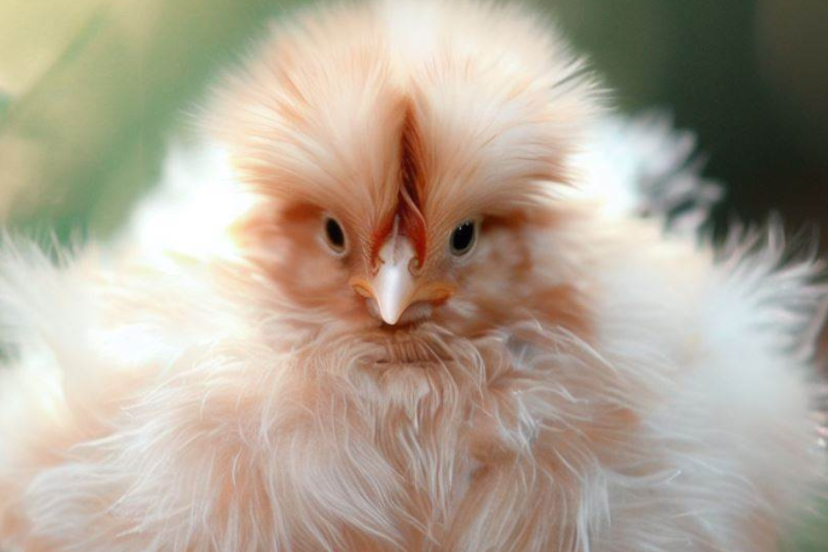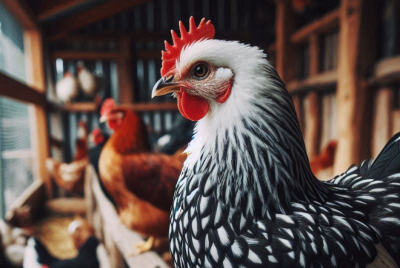Fluffy chickens all you need to know
As a chicken owner , I am delighted to share my knowledge and provide helpful suggestions for anyone interested in Fluffy chickens. Fluffy chickens, known for their soft and abundant plumage, bring joy and charm to any flock. In this article, we will explore what fluffy chickens are, discuss popular breeds, highlight their characteristics, and offer insights into their care and maintenance. I will also provide tips of integrating similar Fluffy flock – Silkie Chickens and Blue Plymouth Rock chickens.
What are Fluffy Chickens?
Fluffy chickens, as the name suggests, are a group of chicken breeds characterized by their soft and fluffy feathers. They are known for their decorative appearance, gentle temperament, and unique feather patterns. Let’s dive deeper and discover the breeds that capture our hearts.
Popular Breeds of Fluffy Chickens
When it comes to fluffy chickens, several breeds stand out for their distinct characteristics and captivating beauty.
Let’s explore a few popular ones:
Silkie Chickens
Silkie chickens are beloved for their exceptionally fluffy feathers that feel like silk. They have a gentle and calm demeanor, making them ideal for families and individuals seeking friendly companionship.
Polish Chickens
Polish chickens are recognized for their eccentric appearance, with their magnificent crest of feathers adorning the top of their heads. Their quirky nature and unique feather patterns make them a favorite among chicken enthusiasts.
Frizzle Chickens
Frizzle chickens have a distinctive feature – their feathers curl outward, creating a whimsical and eye-catching look. Their playful personality and stunning appearance make them a delightful addition to any flock.
Characteristics and Appearance
- Fluffy chickens possess a range of characteristics that make them captivating and endearing.
- Soft and Abundant Feathers
One of the defining features of fluffy chickens is their Soft and Abundant Feathers
One of the defining features of fluffy chickens is their soft and abundant plumage. Their feathers are densely packed and incredibly soft to the touch, givingn them a cuddly and huggable appearance. - Unique Feather Colors and Patterns
They come in a variety of feather colors and patterns, adding to their allure. From pure white to vibrant black, and everything in between, their feathers display a wide range of captivating hues. Some breeds even showcase eye-catching patterns, such as speckles, lacing, or mottling.
Compact Size and Fluffy Plumage
Fluffy chickens are generally smaller in size compared to other chicken breeds. Their compact body structure, combined with their abundant plumage, creates a puffball-like appearance that is simply adorable.
Benefits of Keeping Fluffy Chickens
There are several reasons why keeping fluffy chickens can be a rewarding and enjoyable experience.
Decorative and Adorable Pets
They add a touch of charm and beauty to any backyard or homestead. Their unique appearance and fluffy feathers make them a decorative addition to the flock, providing a visual delight for chicken enthusiasts and passersby alike.
Calm and Gentle Temperament
They are also known for their calm and gentle temperament. They often exhibit friendly and docile behavior, making them suitable for families with children or individuals seeking a peaceful and low-maintenance pet.
Potential for Broodiness and Hatching
Some fluffy chicken breeds have a higher tendency for broodiness, which refers to their inclination to sit on eggs and incubate them. This natural behavior can be advantageous if you are interested in hatching your own chicks.
Housing and Environment
Creating a suitable housing and environment is essential to ensure the well-being and comfort of your fluffy chickens.
Coop Design and Size Requirements
Provide a spacious and secure coop. Consider their small size and ensure adequate space for movement, perching, and nesting. The coop should offer protection against predators and have proper ventilation to maintain good air circulation.
Feeding and Nutrition
Proper nutrition is vital for the health and vitality of your fluffy chickens.
Appropriate Feed and Supplements
Provide a balanced and nutritious feed formulated for chickens, considering their specific breed requirements. The feed should contain essential vitamins, minerals, and protein to support their overall health and feather quality.
Water Requirements
Ensure a constant supply of fresh and clean water . Monitor water containers regularly to prevent contamination or dehydration.
Treats and Scratching Material
Offer occasional treats such as fruits, vegetables, or mealworms as a supplement to their diet. Additionally, provide scratching material like straw or sand, allowing them to exhibit natural behaviors and keep their feathers clean.
Health Care and Maintenance
Maintaining the health and well-being of your fluffy chickens requires attention and proper care.
Regular Health Check-ups
Schedule regular check-ups with a veterinarian who specializes in poultry to monitor the health. They can provide vaccinations, perform necessary tests, and offer guidance on any health concerns.
Parasite Prevention and Treatment
Implement a proactive approach to parasite prevention by regularly inspecting your chickens for signs of infestation. Administer appropriate treatments
Grooming and Feather Maintenance
- Maintaining the feathers of is important for their overall health and appearance. Here are some grooming tips to keep in mind:
- Regularly check and trim their feathers if necessary to prevent them from becoming excessively long or damaged.
- Provide dust baths by providing a shallow container filled with dust or fine sand. This helps them keep their feathers clean and free from mites or lice.Monitor their feet and nails to ensure they are healthy and not overgrown. Trim their nails as needed to prevent discomfort or injury.
Integrating Flock : Blue Plymouth Rock and Fluffy chickens (Silkie Chickens)
When it comes to creating a diverse and visually stunning flock, integrating different chicken breeds can be an exciting venture. In this article, I will guide you through the process of integrating Blue Plymouth Rock and Silkie chickens, two popular and distinct breeds. From understanding their unique traits to implementing proper introduction techniques, you’ll soon have a harmonious flock that combines beauty and charm. Let’s dive in!
Understanding the Breeds:
Blue Plymouth Rock chickens are known for their striking appearance with a combination of blue-gray feathers and bright red combs. They are renowned for their friendly and docile nature, making them excellent additions to any flock. Silkie chickens, on the other hand, captivate with their unique fluffy appearance, feathered feet, and gentle temperament. These gentle creatures are often described as the “lap dogs” of the chicken world. Recognizing the distinct characteristics of each breed is crucial for a successful integration.
Preparing for Integration:
Before introducing Blue Plymouth Rock and Silkie chickens, it’s important to provide them with suitable living conditions. Ensure ample space in your coop or chicken run to accommodate the new additions. Provide separate roosting spots, feeding stations, and nesting areas to minimize competition and establish a sense of territory.
Step-by-Step Integration Process:
1. Quarantine: Begin by quarantining new chickens, including Blue Plymouth Rock and Silkie, for at least two weeks to prevent the spread of potential diseases to your existing flock. Observe their health and behavior during this period.
2. Introduction: Once the quarantine period is over, it’s time to introduce the new chickens to your existing flock. Start by placing them in separate but adjacent enclosures, allowing them to see and hear each other without direct contact. This helps them become familiar with each other’s presence.
3. Supervised Interaction: Gradually introduce short supervised interactions between the two groups. Use a chicken wire fence or similar barrier to prevent physical contact initially. Monitor their behavior closely for signs of aggression or stress.
4. Full Integration: As the chickens become more comfortable with each other, remove the barrier and allow them to coexist freely. However, it’s essential to closely monitor their interactions for any signs of bullying or aggression. Provide multiple food and water stations to minimize competition.
Tips for Successful Integration:
– Introduce new chickens during the daylight hours when they are most active and alert.
– Offer treats and distractions to redirect any aggressive behavior and promote positive associations.
– Ensure a balanced diet for all chickens, including adequate nutrition and access to fresh water.
– Provide hiding spots and extra roosting space to alleviate potential stress and establish a pecking order.
Integrating Blue Plymouth Rock and Silkie chickens into your flock requires patience, observation, and careful planning. By understanding the unique traits of each breed, following the step-by-step integration process, and implementing the provided tips, you can create a harmonious and thriving mixed flock. Enjoy the beauty, diversity, and companionship that Blue Plymouth Rock and Silkie chickens bring to your poultry community!
Remember, successful integration may take time, so be prepared for a gradual transition. With proper care and attention, your Blue Plymouth Rock and Silkie chickens will soon form a bond, enriching your chicken-keeping experience and providing joy for years to come. Happy integrating!
Tips for Fluffy Chicken Care
To ensure the happiness and well-being of your fluffy chickens, consider the following tips:
Socialization and Handling Tips
Spend time with your flock to establish trust and build a bond. Handle them gently and avoid sudden movements to prevent stress. The more comfortable they are with human interaction, the more enjoyable their company will be.
Providing Enrichment and Exercise
Keep your flock mentally stimulated by providing toys, perches, and opportunities for exploration. This helps prevent boredom and encourages natural behaviors. Allow them access to a secure outdoor area where they can scratch, forage, and stretch their wings.
Predator Protection and Safety
Take necessary precautions to protect your fluffy chickens from predators. Secure their coop with sturdy fencing and locks. Regularly inspect the perimeter for potential entry points and reinforce accordingly. Consider installing motion-activated lights or deterrents to discourage predators.
Conclusion
This flock bring a unique and captivating presence to any backyard or homestead. With their soft feathers, charming personalities, and delightful appearance, they are truly a joy to keep. By providing appropriate housing, proper nutrition, and attentive care, you can ensure a happy and healthy life for your fluffy chickens.
FAQs
1. Are fluffy chickens good for beginners?
Yes, they can be a great choice for beginners. They are generally docile and easy to handle, making them suitable for individuals who are new to chicken keeping.
2. How often should I clean the coop of my fluffy chickens?
Regular cleaning of the coop is important to maintain a hygienic environment. Depending on the size of your flock, aim to clean the coop thoroughly at least once a week, removing soiled bedding and sanitizing the area.
3. Can fluffy chickens fly?
Most breeds are not known for their flying abilities. Their compact size and fluffy feathers limit their flight capabilities. However, they can hop and perch on low structures.
4. Do fluffy chickens require special grooming?
They require regular grooming to maintain the health and appearance of their feathers. This includes occasional trimming, dust baths, and nail maintenance.
5. Can I keep fluffy chickens with other chicken breeds?
Yes, they can coexist with other chicken breeds. However, it’s important to consider the compatibility of different breeds in terms of size, temperament, and pecking order dynamics. Introduce them gradually and monitor their interactions to ensure a harmonious flock.
Remember, raising fluffy chickens is not just about their decorative appearance, but also about providing them with a loving and caring environment. Enjoy the journey of fluffy chicken keeping and cherish the unique companionship they bring to your life.
*We may earn a commission from purchases made through our links, at no cost to you. This does not affect our product recommendations. Please see our disclosure to learn more.




